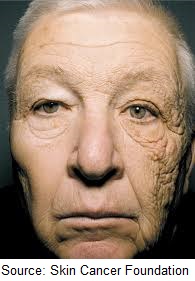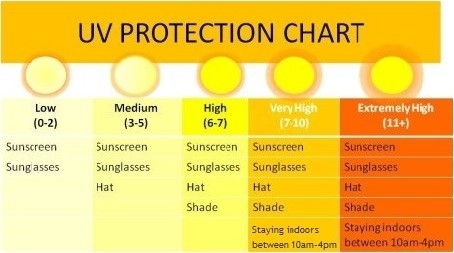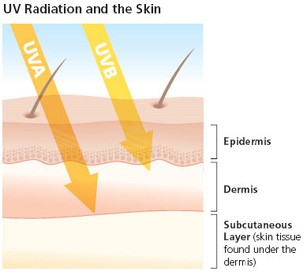Understanding Ultraviolet Radiation
What it is
Radiation emitted from the sun is known as ultraviolet radiation (UVR), and reaches the earth in primarily two forms:
- Ultraviolet A (UVA) rays are long-wave and reach deeper into human skin layers
- Ultraviolet B (UVB) rays are short-wave and damage the top layers of human skin

With even shorter rays than UVB radiation, UVC is absorbed by the ozone layer and does not reach the earth.
What it does
UVR from the sun and tanning beds damages skin cells, causing genetic mutations that can lead to skin cancer. Both the U.S. Department of Health and Human Services (HHS) and the World Health Organization (WHO) have identified UVR as carcinogenic (cancer causing) to humans.
UVR:
- Causes skin cancer
- Causes premature skin aging such as wrinkles, sagging, and age spots
- Causes damage to the eyes, such as cataracts
- Suppresses the immune system
The left side of this life-long truck driver's face shows the damage of UVA passing through the glass of his side window.
UVA
- Penetrates and damages the deeper layers of skin
- Passes through some fabrics, glass, and even some sunscreens
- Primarily causes skin tanning
- Intensity is consistent year-round
UVB
- Penetrates and damages the top layers of skin
- Does not significantly penetrate most fabrics or glass
- Primarily causes skin reddening and sunburn
- Intensity varies by season-UVB is most intense from April-October, but can burn and damage your skin year-round
Environmental factors that affect UVR
Time of day
UV levels vary mainly with the height of the sun in the sky. At midday (10-4pm), the sun's rays take the most direct path to earth. In contrast, during early morning or late afternoon hours the sun's rays pass at a greater angle through the atmosphere. Much more UV radiation is absorbed and less reaches the Earth.
Latitude
UV levels are stronger at locations closer to the equator, where the sun's rays have a shorter distance to travel through the atmosphere. At these low latitudes, less of the harmful UV radiation is absorbed by the atmosphere.
Altitude
Higher altitudes have less atmosphere to absorb UV radiation. For example, you are exposed to more UVR in the mountains than at sea level because there is less atmosphere to for UVR to filter through.

Clouds and haze
Be careful not to underestimate the amount of UV radiation passing through clouds. While your skin may feel cooler on cloudy days, UVR is not related to temperature. While UV levels are highest under cloudless skies, light or thin clouds filter out very little, and may even enhance UV levels because of scattering. Don't be fooled by an overcast day or a cool breeze!
Reflective surfaces
Many surfaces reflect UVR, making exposure more intense. Be aware of reflective surroundings such as:
- Water
- Sand
- Concrete/granite
- Glass
- Snow
What to do
Protect yourself from UV radiation, both indoors and out!
- Always seek the shade outdoors, especially between 10 AM and 4 PM
- Wear sunscreen
- Cover up with a wide-brimmed hat, sunglasses, long-sleeves and pants
- AVOID TANNING in the sun and in tanning beds
- Consider adding tinted UV-protective film to your car's side and rear windows as well as to house and business windows. This film blocks up to 99.9 percent of UV radiation
UV Index Scale

Pay attention to the Daily UV Index - the higher the number, the more you need to protect yourself from the dangers of UV overexposure.
2 or Less: Low
- Low danger from the sun's UV rays for the average person.
- Wear sunglasses on bright days. In winter, reflection off snow can nearly double UV strength.
- If you burn easily, cover up and use sunscreen.
3 - 5: Moderate
- Moderate risk of harm from unprotected sun exposure.
- Take precautions, such as covering up, if you will be outside.
- Stay in shade near midday when the sun is strongest.
6 - 7: High
- High risk of harm from unprotected sun exposure.
- Apply a sunscreen with a SPF of 30 or higher. Wear a wide-brim hat and sunglasses to protect your eyes.
- Protection against sunburn is needed.
- Reduce time in the sun between 10 a.m. and 4 p.m.
- Cover up, wear a hat and sunglasses, and use sunscreen.
8 - 10: Very High
- Very high risk of harm from unprotected sun exposure.
- Protect yourself by liberally applying a sunscreen with a SPF of 30 or higher. Wear protective clothing and sunglasses to protect the eyes.
- Take extra precautions. Unprotected skin will be damaged and can burn quickly.
- Minimize sun exposure between 10 a.m. and 4 p.m. Otherwise, seek shade, cover up, wear a hat and sunglasses, and use sunscreen.
11+: Extreme
- Extreme risk of harm from unprotected sun exposure.
- Avoid sun exposure throughout the day as much as possible.
- Seek shade, cover up, wear a hat and sunglasses, and use sunscreen.
- Apply sunscreen with a SPF of 30 or higher liberally every 2 hours if you're outside.
- Take all precautions. Unprotected skin can burn in minutes. Beachgoers should know that white sand and other bright surfaces reflect UV and will increase UV exposure.
Check the UV index in your area!
References
World Health Organization ( http://www.who.int/uv/faq/whatisuv/en/) Skin Cancer Foundation (http://www.skincancer.org/prevention/uva-and-uvb)



